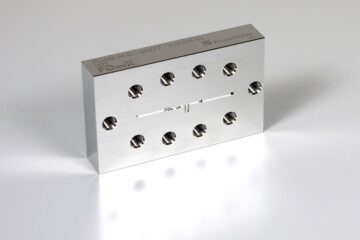Playing billiards with light provides cheaper lasers

Dutch physicists from Leiden University have made an experimental laser that combines the advantages of two types of laser. With the experimental laser, which generates light in a sort of billiards table with round edges, the researchers have demonstrated that is possible to produce cheaper lasers.
A conventional laser reflects light between two very accurately positioned mirrors, the so-called resonant cavity. The distance between the mirrors determines which wavelength is amplified and therefore which colour of light remains. Conventional lasers are expensive due to the costs of the mirrors. This is because the mirrors in a laser have to be very accurately curved. Furthermore, the form and the quality of the mirrors must satisfy stringent technical specifications and the distance between the mirrors has to be set and maintained with extreme precision.
The ’’random laser’’ provides an alternative. Such a laser is much less sensitive to technical imperfections of the resonant cavity, for example. A random laser works with a large number of different light colours. Up until now this type of laser has worked using light-diffusing particles and this has a number of disadvantages. Physicists would prefer such lasers to make use of mirrors.
Jos Dingjan’s doctoral research contributed to the successful construction of an experimental random laser that works with mirrors. The resonant cavity consists of three standard mirrors which produce a resonant cavity in the form of a billiards table with ’’round’’ corners. The mirrors are easily placed in a variety of set-ups on an experimental table. This enables the researchers to perform a wide range of experiments.
The middle mirror, half way along the radiation passage of the light, is located almost perpendicularly. This causes the necessary disruption to the light waves. The desired wave chaos was found to arise at the third mirror. With the addition of a light amplifier a laser beam can in principle be generated here.
Media Contact
More Information:
http://www.nwo.nlAll latest news from the category: Physics and Astronomy
This area deals with the fundamental laws and building blocks of nature and how they interact, the properties and the behavior of matter, and research into space and time and their structures.
innovations-report provides in-depth reports and articles on subjects such as astrophysics, laser technologies, nuclear, quantum, particle and solid-state physics, nanotechnologies, planetary research and findings (Mars, Venus) and developments related to the Hubble Telescope.
Newest articles

FDmiX: Fast, robust series production of nanoparticles
Nucleic acid-based medications such as mRNA vaccines are opening up new therapeutic approaches. These active ingredients must be enclosed inside nanoparticles to ensure that they get to where they are…

Sensor measures oxygen content of breath
Oxygen saturation in the blood that is either too low or too high can cause physical harm or even death. This is why patients’ oxygen concentraions are monitored continuously in…

Laser immersion probe for smart inline monitoring of water and wastewater
A new type of laser-based immersion probe, which the Fraunhofer Institute for Laser Technology ILT in Aachen is testing as part of BMBF- and EU-funded projects with industrial partners and…





















